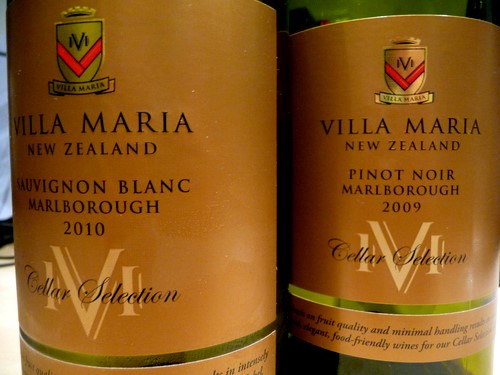Very impressed by this pair by Villa Maria, one of New Zealand’s most consistent producers.
Villa Maria Cellar Selection Pinot Noir 2009 Marlborough
Seriously seductive Pinot. Sweet cherry and berry fruit with fresh herb and mineral notes, as well as subtle meatiness. The palate is ripe and sweetly fruited, yet supple and fresh with nice acidity, sour cherry notes and hints of savoury minerality. Rich, but with some elegance and non-fruit complexity. 92/100 (£14.99 Majestic, Rhythm and Booze, Booths)
Villa Maria Cellar Selection Sauvignon Blanc 2010 Marlborough
Amazingly lively and aromatic, this is a really rich, forward style of Sauvignon. It’s concentrated with passionfruit richness, grapefruit freshness and some sweet grapey notes. Good acidity and rich texture, with subtle green notes too. 90/100 (£11.99 Tesco, Majestic, Rhythm and Booze)

Hi Jamie,
Sorry to labour the point, but I have to question your scoring system!
I commented on the scores you gave those Quinta wines (88 and 89), when you made a point of saying how “disappointed” you were with them (“they aren’t great” etc).
And yet, with these Villa Maria wines, despite saying that you are “very impressed” by them, one of them gets 90, just one point more!
If you’re really not that impressed with a wine, why not give it a more appropriate score, ie something around the 60-65 mark? I just don’t see how 88-89 can equal a “disappointing” wine and yet 90 is amazing???
I tried the 2008 releases, which include the two Quinta wines and two more commercial brands. I’ll be honest: I was a little disappointed with the two Quinta wines. These are not in the same league as some of the top Douro table wines now being released. It’s not that they are bad wines; just that they aren’t great – and these are not cheap, either (£25-£40).
François Lurton Quinta Beira Douro 2008 Douro, Portugal
A 10 hectare vineyard close to Pinhão, north facing. 15% alcohol. Gravelly, slightly tarry nose with fresh plum and blackberry fruit. Midweight palate with fresh, tarry, spicy red and black fruits and a bit of savoury grip, with some tannic structure. High alcohol yet lacks real concentration of flavour. 88/100
François Lurton Quinta do Malhô 2008 Douro, Portugal
From a south-facing vineyard in the Torto Valley. 15% alcohol. Ripe yet fresh berry and cherry fruits nose is taut and focused with some new oak spiciness. The palate is more red fruits than black – this certainly isn’t jammy or overripe – but it shows high alcohol, despite this, as well as some new oak. One to cellar for a few years? 89/100
I totally agree with John. Every wine gets the same scores. Live dangerously and tell us what you really think, good or bad…
The price is also tacitly considered, otherwise you’re comparing apples and asparagus. A ninety point wine for a tenner outranks a ninety point wine costing twice as much. And the scale, based on US college marking and familiar to every other reader, starts at fifty- drinkable i.e. not actively faulty or poisonous- to one hundred- fit only for gullible Russian or Chinese billionaires.
The issue is this. I hate scores, but readers like a score to see how much I really liked the wine.
And scoring on the 100 point scale means you have to calibrate with Parker and the WS. They are powerful, and have set the standard for using the 100 point score.
This means that you have an effective range of 85-100 for decent wine. This means that every point counts, and the difference between 88 and 92 is quite big.
It’s an absolute scale, too. So an 89 pt high end Douro red selling for £30 is disappointing, while a £12 Marlborough Sauvignon scoring 90 is pretty good.
I apologise for the silliness of my scoring – I’m just trying to do as well as I can given these constraints.
One day I may be famous enough to be able to set my own standard of scoring – but don’t hold your breath!
Fair point Jamie, but if you say you can only use between 85-100 why not just score everything from 0-15. Having a system whereby you ignore 85% of the potential score seems a bit silly…
Don’t see why you feel obliged to bow down to Parker and the WS.
Not many other wine writers are bound by these “constraints”.
If you choose to score wines out of 100, then a single point’s difference should be far less significant than a point difference in a 10- or 20-point system.
I think your system is just confusing, and rather illogical.
I can see why you use the Parker system, Jamie, but do think you perhaps overestimate its universality, certainly outside the anglophone countries.
In response to John, if you look at people who use a twenty-point scale, you’ll see nearly all marks are between 12 and 18, and the vast majority between 14 and 17 🙂
I have my own rating scale for wines I’ve tasted
1 – terrible wine that I’d never buy again
2 – ok but would have to drink after a few other bottles
3 – nice braai and every day wine that I’d take to a braai or dinner with people that don’t really know wines and wouldn’t appreciate a really good wine but would nnot enjoy a bad wine
4 – really nice wine that I’d only open with people who appreciate good wine, definitely not around a braai.
5 – brilliant wine for special occassions only
‘Why not score from 0-15’?
Because then some wines would have to be marked 0 or 1 or 2. No more free wine for you!